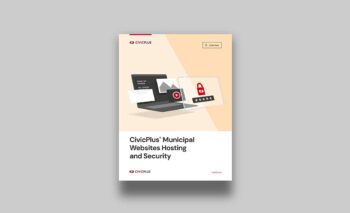Ensuring Digital Supply Chain Security
What State and Local Government Agencies Need to Know in the Aftermath of the CrowdStrike Incident
In an increasingly interconnected and technologically advanced world, digital supply chain security has become a critical concern for private and public sector entities alike. The unprecedented information technology (IT) outage triggered by a software update from CrowdStrike, a leading cybersecurity firm, highlighted the potential for vulnerabilities within the digital supply chain that can have far-reaching consequences.
At the same time, state and local government agencies are tasked with protecting our nation’s infrastructure from cybersecurity threat actors not limited by geographic boundaries, often turning to technology vendors for software and solutions boasting robust cybersecurity postures.
The CrowdStrike incident serves as a stark reminder of the importance of third-party risk management in the digital supply chain. “Bad actors” are not the only threat to cybersecurity. And yet, with national security hinging on government cybersecurity practices at all levels, the state and local agencies themselves are parties capable of creating risk.
The question is: What’s a state or local government agency to do?
Follow These 3 Digital Supply Chain Security Best Practices:
1. Embrace Third-Party Risk Management
CrowdStrike, known for its advanced threat intelligence and cybersecurity solutions, faced what has been described as the biggest outage in modern computing history. The outage disrupted services and exposed potential weaknesses in the digital supply chain, where third-party components and services are integrated into an entity’s infrastructure. This incident underscores how even the most sophisticated cybersecurity firms are not immune to creating digital supply chain vulnerabilities.
The Ripple Effect of Digital Supply Chain Vulnerabilities
Supply chain attacks can be particularly insidious because they exploit trusted relationships between entities and their suppliers. When a supplier is compromised, a domino effect can be created, impacting all organizations reliant upon the supplier’s services. In the case of CrowdStrike, the outage not only affected the vendor’s clients but also raised broader concerns about the reliability and security of digital supply chains everywhere.
What Can State and Local Government Agencies Do?
Given the digital supply chain vulnerabilities highlighted by the CrowdStrike incident, state and local government agencies should carefully vet technology vendors through the lens of third-party risk management. According to Supply Chain Connect:
- Manage and review vendor performance and dependencies continuously using real-time risk identification to enhance visibility and prevention.
- Establish transparent, collaborative relationships with vendors by sharing information, risk assessments, and response plans to identify and address potential issues swiftly.
- Educate staff about digital supply chain security as well as cybersecurity best practices like recognizing phishing attempts, using strong passwords, and understanding the importance of regular software updates.
2. Choose Technology Vendors With Truly Robust Cybersecurity Postures
By investing in the right technology, state and local government agencies can reduce the costs associated with supply chain disruptions and better protect against cyber and operational risks.
Municipal Websites: Prime Targets
Municipal websites, which serve as community hubs for public services and information, are becoming popular targets for cyber attacks. These websites often handle sensitive data regarding residents and infrastructure, attracting exploitation by cyber threat actors. The security of these websites is paramount to ensure the integrity and availability of public services — as well as the security of our nation.
Related Read – The Top 4 Security Threats Facing Local Governments Today
What Can State and Local Government Agencies Do?
Ask any potential website or technology vendor about its quality assurance practices surrounding software updates. Inquire about testing processes, acceptance checks, deployment stages, and adherence to Secure by Design principles. Give preference to vendors that:
- Conduct regular security audits to help identify and mitigate vulnerabilities. This proactive approach addresses potential risks before they can be exploited as threats.
- Utilize multi-factor authentication to add an extra layer of security, making it more difficult for unauthorized users to gain access to websites and systems.
- Leverage incident response planning to ensure quick and effective action is taken to combat cyber incidents, minimizing damages and recovery times.
3. Enable Automatic Software Updates
Despite the risks associated with software updates, state and local governments should continue enabling automatic updates as they are crucial for cybersecurity, particularly as cyber threats become increasingly more complex.
The Growing Sophistication of Cyber Threats
While the botched CrowdStrike software update negatively affected the operations of organizations around the globe, with Fortune 500 companies alone facing potential losses of over $5 billion, the IT outage caused by the update also left those entities vulnerable — allowing cyber threat actors to launch phishing attacks to exploit weakened defenses.
What Can State and Local Government Agencies Do?
It would be a mistake for state and local government agencies to disable automatic software updates. These updates provide vital lines of defense against an ever-evolving cyber threat landscape. Operational continuity for the interrupted delivery of public services is a major concern, but agencies must activate every weapon in their cybersecurity arsenals. To mitigate the risk of disruption:
- Establish detailed incident response plans.
- Consider scheduling automatic software updates to install after standard operating hours.
- Ensure staff are well-trained to execute established incident response plans and support in this capacity after hours.
Conclusion
The CrowdStrike incident illuminates the critical importance of supply chain security in the digital realm. For state and local government agencies, the incident underscores the necessity of embracing third-party risk management, choosing technology vendors with truly robust cybersecurity postures, and continuing to enable automatic software updates to safeguard against increasingly sophisticated cyber threats. Maintaining a vigilant and proactive approach to cybersecurity is key to protecting our communities, our quality of life, and our nation.
Next Step – Explore the Cybersecurity Posture of CivicPlus® and Its Municipal Website Solution Now



